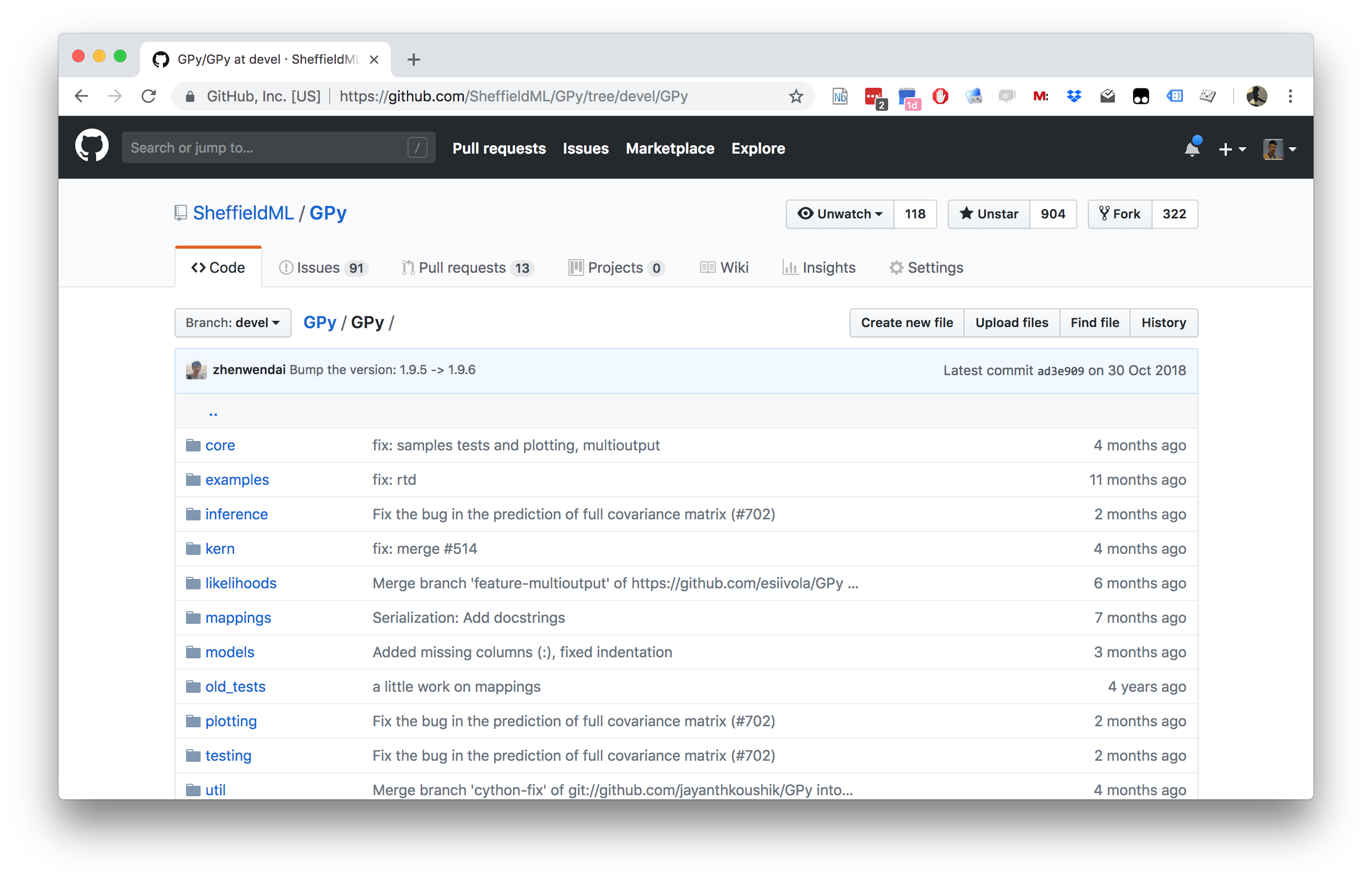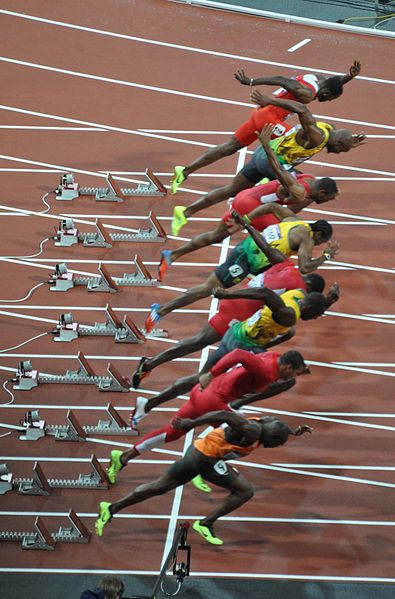Multi-output Gaussian Processes
GPy: A Gaussian Process Framework in Python

GPy: A Gaussian Process Framework in Python
- BSD Licensed software base.
- Wide availability of libraries, ‘modern’ scripting language.
- Allows us to set projects to undergraduates in Comp Sci that use GPs.
- Available through GitHub https://github.com/SheffieldML/GPy
- Reproducible Research with Jupyter Notebook.
Features
- Probabilistic-style programming (specify the model, not the algorithm).
- Non-Gaussian likelihoods.
- Multivariate outputs.
- Dimensionality reduction.
- Approximations for large data sets.
Simple Kalman Filter
We have state vector \(\mathbf{X}= \left[\mathbf{ x}_1 \dots \mathbf{ x}_q\right] \in \mathbb{R}^{T \times q}\) and if each state evolves independently we have \[ \begin{align*} p(\mathbf{X}) &= \prod_{i=1}^qp(\mathbf{ x}_{:, i}) \\ p(\mathbf{ x}_{:, i}) &= \mathcal{N}\left(\mathbf{ x}_{:, i}|\mathbf{0},\mathbf{K}\right). \end{align*} \]
We want to obtain outputs through: \[ \mathbf{ y}_{i, :} = \mathbf{W}\mathbf{ x}_{i, :} \]
Stacking and Kronecker Products
- Represent with a ‘stacked’ system: \[ p(\mathbf{ x}) = \mathcal{N}\left(\mathbf{ x}|\mathbf{0},\mathbf{I}\otimes \mathbf{K}\right) \] where the stacking is placing each column of \(\mathbf{X}\) one on top of another as \[ \mathbf{ x}= \begin{bmatrix} \mathbf{ x}_{:, 1}\\ \mathbf{ x}_{:, 2}\\ \vdots\\ \mathbf{ x}_{:, q} \end{bmatrix} \]
Kronecker Product
Kronecker Product
Stacking and Kronecker Products
- Represent with a ‘stacked’ system: \[p (\mathbf{ x}) = \mathcal{N}\left(\mathbf{ x}|\mathbf{0},\mathbf{I}\otimes \mathbf{K}\right) \] where the stacking is placing each column of \(\mathbf{X}\) one on top of another as \[ \mathbf{ x}= \begin{bmatrix} \mathbf{ x}_{:, 1}\\ \mathbf{ x}_{:, 2}\\ \vdots\\ \mathbf{ x}_{:, q} \end{bmatrix} \]
Column Stacking
For this stacking the marginal distribution over time is given by the block diagonals.
Two Ways of Stacking
Can also stack each row of \(\mathbf{X}\) to form column vector: \[\mathbf{ x}= \begin{bmatrix} \mathbf{ x}_{1, :}\\ \mathbf{ x}_{2, :}\\ \vdots\\ \mathbf{ x}_{T, :} \end{bmatrix}\] \[p(\mathbf{ x}) = \mathcal{N}\left(\mathbf{ x}|\mathbf{0},\mathbf{K}\otimes \mathbf{I}\right)\]
Row Stacking
For this stacking the marginal distribution over the latent dimensions is given by the block diagonals.
Mapping from Latent Process to Observed
Observed Process
The observations are related to the latent points by a linear mapping matrix, \[ \mathbf{ y}_{i, :} = \mathbf{W}\mathbf{ x}_{i, :} + \boldsymbol{ \epsilon}_{i, :} \] \[ \boldsymbol{ \epsilon}\sim \mathcal{N}\left(\mathbf{0},\sigma^2\mathbf{I}\right) \]
Output Covariance
This leads to a covariance of the form \[ (\mathbf{I}\otimes \mathbf{W}) (\mathbf{K}\otimes \mathbf{I}) (\mathbf{I}\otimes \mathbf{W}^\top) + \mathbf{I}\sigma^2 \] Using \((\mathbf{A}\otimes\mathbf{B}) (\mathbf{C}\otimes\mathbf{D}) = \mathbf{A}\mathbf{C} \otimes \mathbf{B}\mathbf{D}\) This leads to \[ \mathbf{K}\otimes {\mathbf{W}}{\mathbf{W}}^\top + \mathbf{I}\sigma^2 \] or \[ \mathbf{ y}\sim \mathcal{N}\left(\mathbf{0},\mathbf{W}\mathbf{W}^\top \otimes \mathbf{K}+ \mathbf{I}\sigma^2\right) \]
Kernels for Vector Valued Outputs: A Review
Kronecker Structure GPs
This Kronecker structure leads to several published models. \[ (\mathbf{K}(\mathbf{ x},\mathbf{ x}^\prime))_{i,i^\prime}=k(\mathbf{ x},\mathbf{ x}^\prime)k_T(i,i^\prime), \] where \(k\) has \(\mathbf{ x}\) and \(k_T\) has \(n\) as inputs.
Can think of multiple output covariance functions as covariances with augmented input.
Alongside \(\mathbf{ x}\) we also input the \(i\) associated with the output of interest.
Separable Covariance Functions
Taking \(\mathbf{B}= {\mathbf{W}}{\mathbf{W}}^\top\) we have a matrix expression across outputs. \[\mathbf{K}(\mathbf{ x},\mathbf{ x}^\prime)=k(\mathbf{ x},\mathbf{ x}^\prime)\mathbf{B},\] where \(\mathbf{B}\) is a \(p\times p\) symmetric and positive semi-definite matrix.
\(\mathbf{B}\) is called the coregionalization matrix.
We call this class of covariance functions separable due to their product structure.
Sum of Separable Covariance Functions
In the same spirit a more general class of kernels is given by \[\mathbf{K}(\mathbf{ x},\mathbf{ x}^\prime)=\sum_{j=1}^qk_{j}(\mathbf{ x},\mathbf{ x}^\prime)\mathbf{B}_{j}.\]
This can also be written as \[\mathbf{K}(\mathbf{X}, \mathbf{X}) = \sum_{j=1}^q\mathbf{B}_{j}\otimes k_{j}(\mathbf{X}, \mathbf{X}),\]
This is like several Kalman filter-type models added together, but each one with a different set of latent functions.
We call this class of kernels sum of separable kernels (SoS kernels).
Geostatistics
Use of GPs in Geostatistics is called kriging.
These multi-output GPs pioneered in geostatistics: prediction over vector-valued output data is known as cokriging.
The model in geostatistics is known as the linear model of coregionalization (LMC, Journel and Huijbregts (1978) Goovaerts (1997)).
Most machine learning multitask models can be placed in the context of the LMC model.
Weighted sum of Latent Functions
In the linear model of coregionalization (LMC) outputs are expressed as linear combinations of independent random functions.
In the LMC, each component \(f_i\) is expressed as a linear sum \[f_i(\mathbf{ x}) = \sum_{j=1}^q{w}_{i,{j}}{u}_{j}(\mathbf{ x}).\] where the latent functions are independent and have covariance functions \(k_{j}(\mathbf{ x},\mathbf{ x}^\prime)\).
The processes \(\{f_j(\mathbf{ x})\}_{j=1}^q\) are independent for \(q\neq {j}^\prime\).
Kalman Filter Special Case
The Kalman filter is an example of the LMC where \({u}_i(\mathbf{ x}) \rightarrow {x}_i(t)\).
I.e. we’ve moved form time input to a more general input space.
In matrix notation:
- Kalman filter \[\mathbf{F}= {\mathbf{W}}\mathbf{X}\]
- LMC \[\mathbf{F}= {\mathbf{W}}{\mathbf{U}}\] where the rows of these matrices \({\mathbf{F}}\), \(\mathbf{X}\), \({\mathbf{U}}\) each contain \(q\) samples from their corresponding functions at a different time (Kalman filter) or spatial location (LMC).
Intrinsic Coregionalization Model
If one covariance used for latent functions (like in Kalman filter).
This is called the intrinsic coregionalization model (ICM, Goovaerts (1997)).
The kernel matrix corresponding to a dataset \(\mathbf{X}\) takes the form \[ \mathbf{K}(\mathbf{X}, \mathbf{X}) = \mathbf{B}\otimes k(\mathbf{X}, \mathbf{X}). \]
Autokrigeability
If outputs are noise-free, maximum likelihood is equivalent to independent fits of \(\mathbf{B}\) and \(k(\mathbf{ x}, \mathbf{ x}^\prime)\) (Helterbrand and Cressie, 1994).
In geostatistics this is known as autokrigeability (Wackernagel, 2003).
In multitask learning its the cancellation of intertask transfer (Bonilla et al., n.d.).
Intrinsic Coregionalization Model
\[ \mathbf{K}(\mathbf{X}, \mathbf{X}) = \mathbf{ w}\mathbf{ w}^\top \otimes k(\mathbf{X}, \mathbf{X}). \]
\[ \mathbf{ w}= \begin{bmatrix} 1 \\ 5\end{bmatrix} \] \[ \mathbf{B}= \begin{bmatrix} 1 & 5\\ 5&25\end{bmatrix} \]
Intrinsic Coregionalization Model Covariance

|
Intrinsic Coregionalization Model
\[ \mathbf{K}(\mathbf{X}, \mathbf{X}) = \mathbf{B}\otimes k(\mathbf{X}, \mathbf{X}). \]
\[ \mathbf{B}= \begin{bmatrix} 1 & 0.5\\ 0.5& 1.5\end{bmatrix} \]
LMC Samples
\[\mathbf{K}(\mathbf{X}, \mathbf{X}) = \mathbf{B}_1 \otimes k_1(\mathbf{X}, \mathbf{X}) + \mathbf{B}_2 \otimes k_2(\mathbf{X}, \mathbf{X})\]
\[\mathbf{B}_1 = \begin{bmatrix} 1.4 & 0.5\\ 0.5& 1.2\end{bmatrix}\] \[{\ell}_1 = 1\] \[\mathbf{B}_2 = \begin{bmatrix} 1 & 0.5\\ 0.5& 1.3\end{bmatrix}\] \[{\ell}_2 = 0.2\]
LMC in Machine Learning and Statistics
Used in machine learning for GPs for multivariate regression and in statistics for computer emulation of expensive multivariate computer codes.
Imposes the correlation of the outputs explicitly through the set of coregionalization matrices.
Setting \(\mathbf{B}= \mathbf{I}_p\) assumes outputs are conditionally independent given the parameters \(\boldsymbol{ \theta}\). (Lawrence and Platt, 2004; Minka and Picard, 1997; Yu et al., 2005).
More recent approaches for multiple output modeling are different versions of the linear model of coregionalization.
Semiparametric Latent Factor Model
Coregionalization matrices are rank 1 Teh et al. (n.d.). rewrite equation as \[\mathbf{K}(\mathbf{X}, \mathbf{X}) = \sum_{j=1}^q\mathbf{ w}_{:, {j}}\mathbf{ w}^{\top}_{:, {j}} \otimes k_{j}(\mathbf{X}, \mathbf{X}).\]
Like the Kalman filter, but each latent function has a different covariance.
Authors suggest using an exponentiated quadratic characteristic length-scale for each input dimension.
Semi Parametric Latent Factor Covariance
Semiparametric Latent Factor Model Samples
\[ \mathbf{K}(\mathbf{X}, \mathbf{X}) = \mathbf{ w}_{:, 1}\mathbf{ w}_{:, 1}^\top \otimes k_1(\mathbf{X}, \mathbf{X}) + \mathbf{ w}_{:, 2} \mathbf{ w}_{:, 2}^\top \otimes k_2(\mathbf{X}, \mathbf{X}) \]
\[ \mathbf{ w}_1 = \begin{bmatrix} 0.5 \\ 1\end{bmatrix} \] \[ \mathbf{ w}_2 = \begin{bmatrix} 1 \\ 0.5\end{bmatrix} \]
Gaussian processes for Multi-task, Multi-output and Multi-class
Bonilla et al. (n.d.) suggest ICM for multitask learning.
Use a PPCA form for \(\mathbf{B}\): similar to our Kalman filter example.
Refer to the autokrigeability effect as the cancellation of inter-task transfer.
Also discuss the similarities between the multi-task GP and the ICM, and its relationship to the SLFM and the LMC.
Multitask Classification
Mostly restricted to the case where the outputs are conditionally independent given the hyperparameters \(\boldsymbol{\phi}\) (Lawrence and Platt, 2004; Minka and Picard, 1997; Rasmussen and Williams, 2006; Seeger and Jordan, 2004; Williams and Barber, 1998; Yu et al., 2005).
Intrinsic coregionalization model has been used in the multiclass scenario. Skolidis and Sanguinetti (2011) use the intrinsic coregionalization model for classification, by introducing a probit noise model as the likelihood.
Posterior distribution is no longer analytically tractable: approximate inference is required.
Computer Emulation
A statistical model used as a surrogate for a computationally expensive computer model.
Higdon et al. (2008) use the linear model of coregionalization to model images representing the evolution of the implosion of steel cylinders.
In Conti and O’Hagan (2009) use the ICM to model a vegetation model: called the Sheffield Dynamic Global Vegetation Model Woodward et al. (1998).
Modelling Multiple Outputs
Running Example
Olympic Sprint Data
|

|
Olympic Sprint Data
Gaussian Process Fit
Olympic Marathon Data GP
Olympic Marathon Data LMC GP
Olympic Marathon Data ICM GP
Thanks!
- twitter: @lawrennd
- podcast: The Talking Machines
- newspaper: Guardian Profile Page
- blog: http://inverseprobability.com